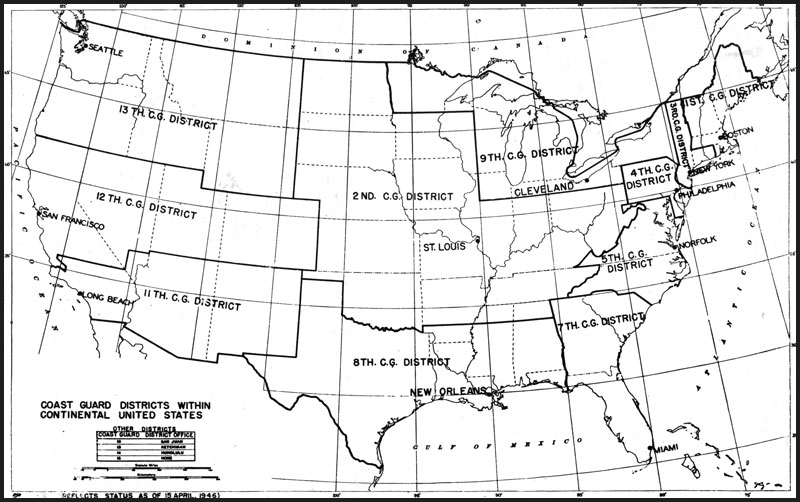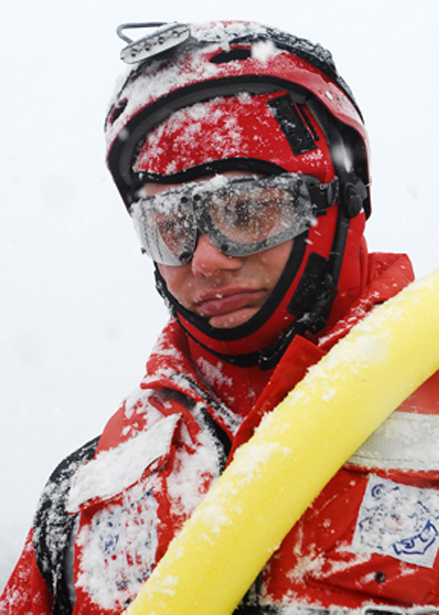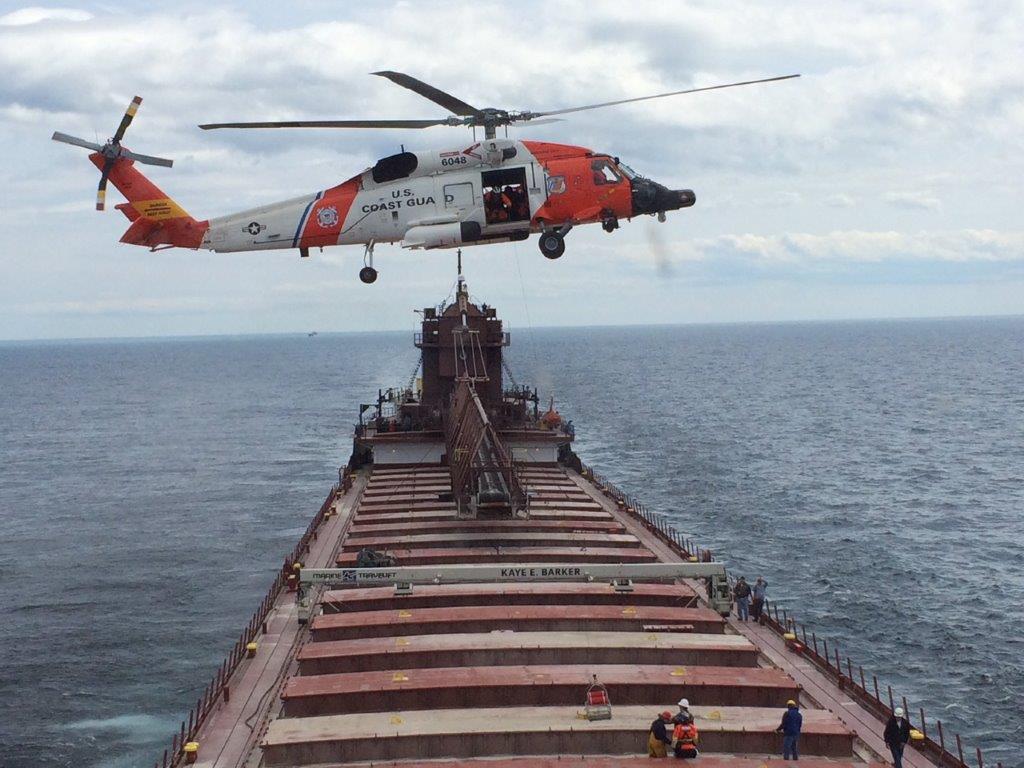 Within an area occupied by the states bordering the Great Lakes is located the U.S. Coast Guard’s Ninth District. The service’s presence on the Great Lakes began in the 19th century with the appearance of four Coast Guard predecessor agencies. These included the U.S. Revenue Cutter Service, U.S. Lighthouse Service, Steamboat Inspection Service and U.S. Life-Saving Service.
Within an area occupied by the states bordering the Great Lakes is located the U.S. Coast Guard’s Ninth District. The service’s presence on the Great Lakes began in the 19th century with the appearance of four Coast Guard predecessor agencies. These included the U.S. Revenue Cutter Service, U.S. Lighthouse Service, Steamboat Inspection Service and U.S. Life-Saving Service.
The Revenue Cutter Service enforced U.S. laws on the Great Lakes ensuring compliance with customs requirements. Soon after the War of 1812, a revenue cutter was stationed on the Great Lakes and the number of cutters increased throughout the 19th century. Revenue cutters were also charged with rescue operations, patrolling regattas, and several cutters left the Great Lakes to support combat operations in the Civil War and Spanish-American War.
increased throughout the 19th century. Revenue cutters were also charged with rescue operations, patrolling regattas, and several cutters left the Great Lakes to support combat operations in the Civil War and Spanish-American War.
The Lighthouse Service expanded rapidly along the Great Lakes from east to west, keeping pace with the region’s settlement and the growth of shipping. Records indicate that the first appropriations were made for lighthouses in eastern Lake Erie and western Lake Ontario. The first lighthouse tenders also began servicing the region’s floating aids-to-navigation and fog signals. And, by the late 1800s, 20 lightships were stationed on the Great Lakes.
The advent of steam-propelled vessels came with increased risks of boiler explosions and marine casualties. In 1838, hull and boiler inspectors were given federal authority to survey and certify passenger vessels. In 1871, increasing casualties resulted in additional laws that gave rise to the Steamboat Inspection Service (SIS) under the Treasury Department. In addition to boiler and hull examinations, subsequent laws required lifesaving, firefighting, manning and safety measures. These requirements included the licensing of commercial operators and engineers and were later extended to passenger vessels. On the Great Lakes, two SIS districts were established to provide inspection services. Headquartered in Detroit, one oversaw the western Lakes, while the Cleveland office managed inspectors on lakes Erie and Ontario and the St. Lawrence River.
The increasing rate of commercial shipwrecks required the capability to rescue distressed mariners. Beginning in the 1840s, both the Revenue Cutter Service and the Lighthouse Service were informally tasked with providing rescue services. Unfortunately, a lack of organization, funding and training resulted in ineffective lifesaving operations. So, from 1876 to 1877, 28 dedicated and properly funded lifesaving stations were established on the Great Lakes. Some were co-located with lighthouses and staffed with a mix of full-time and volunteer crews.
In 1878, the U.S. Life-Saving Service was formally established under the Treasury Department. By 1893, there were 47 manned stations on the shores of the Great Lakes and, by 1900, this number grew to 60 stations. The Life-Saving Service’s first motorized lifeboat (MLB) was assigned to Marquette Michigan and MLBs were adopted for use across the Great Lakes by the early part of the 20th century.
In 1915, legislation unifying the Life-Saving Service and the Revenue Cutter Service established the modern-day Coast Guard and increased the service’s scope and capabilities on the Great Lakes. In 1920, the service’s law enforcement mission on the northern border grew exponentially with the passage of the Volstead Act, which implemented Prohibition for the next 14 years. Coast Guard smallboats and larger patrol boats intercepted illegal  alcohol smuggled by boat from Canada at various border-crossing areas on the Lakes. In addition, the service’s search and rescue mission grew in response to the arrival of the recreational boating during the warmer months.
alcohol smuggled by boat from Canada at various border-crossing areas on the Lakes. In addition, the service’s search and rescue mission grew in response to the arrival of the recreational boating during the warmer months.
In the early 1900s, steel-hulled Coast Guard cutters had been tasked with breaking ice on the Lakes in an effort to extend the shipping season. To ensure the year-round transport of heating oil and the shipment of iron ore and other raw materials, icebreaking became a national priority from the late 1930s through World War II. In 1936, President Franklin Roosevelt signed Executive Order Number 7521 assigning domestic icebreaking to the Coast Guard. This mission resulted in additional Coast Guard icebreaking vessels, including a class of 180-foot light icebreaking buoy tenders and the Great Lakes icebreaker Mackinaw, built in 1943.
Great Lakes cutters also served in the world wars when the service temporarily came under the control of the U.S. Navy. During World War I, the service had amalgamated the Areas, Districts and Divisions of predecessor agencies into Naval Districts while under control of the U.S. Navy. The port safety and security authority for the Captains of the Port (COTPs) began in World War I and greatly expanded during World War II due to both national security demands and legislation.
During World War II, two captains served as the first Ninth District commanders followed in 1944 by the first Ninth District flag officer, Commodore James Hirshfield. Of note, on June 13, 1943, the Michigan-based Coast Guard Cutter Escanaba was lost during Atlantic convoy escort duty leaving two survivors out of its 105-man crew. The cutter was mourned and memorialized by its homeport of Grand Haven.
The Coast Guard’s mission set for the Great Lakes expanded after World War II. This was due in part to the 1939 transfer of the U.S. Lighthouse Service to the Coast Guard and the 1946 absorption of the Bureau of Marine Inspection and Navigation (formerly the SIS). Two thousand aids-to-navigation and ten lighthouse tenders joined the Coast Guard’s Great Lakes inventory. Created during World War II, the Coast Guard Reserve and the Auxiliary became critical components for the safety, security and stewardship of the Great Lakes. In addition, in 1946, the District’s first air station was established at Traverse City, Michigan, with one fixed-wing aircraft followed by the use of helicopters.
During the 20 years following World War II, Ninth District field units were organized under 11 Groups with 29 Captains of the Port and Marine Inspection Offices (MIOs). Several Group commanders  oversaw two or three commands simultaneously. During this period, the Ninth District maintained two icebreakers, seven 180-foot buoy tenders, a lightship, five icebreaking harbor tugs, 51 stations and 80 manned lighthouses.
oversaw two or three commands simultaneously. During this period, the Ninth District maintained two icebreakers, seven 180-foot buoy tenders, a lightship, five icebreaking harbor tugs, 51 stations and 80 manned lighthouses.
In the 1960s, the Ninth District experienced further changes. In 1959, the St. Lawrence Seaway had opened allowing foreign-flagged vessels into the Great Lakes along with invasive species carried in their ballast tanks. In the 1960s and 1970s, this situation led to Coast Guard enforcement of new ballast water and waste water discharge regulations. Meanwhile, in 1966, the Coast Guard had established Air Station Detroit and, a year later, the Coast Guard was transferred from the Treasury Department to the Department of Transportation. Two years later, in 1969, the service also established Air Station Chicago.
The next significant mission added to the Coast Guard and Ninth District was marine environmental protection. Several high profile oil spills and events, including the infamous 1969 Cuyahoga River fire at Cleveland, increased environmental awareness. That awareness resulted in legislation, such as the Federal Water Pollution Control Act, and other marine pollution laws and treaties. In 1972, this led to a merger of COTP and MIO commands into Marine Safety Offices (MSOs) located in ports across the Ninth District.
 Over the next 30 years, the organization of field units evolved and consolidated due to advances in technology and asset capabilities. The 11 Groups merged into five and the marine safety program consolidated into eight MSOs and three Marine Safety Detachments. Meanwhile, the service closed Air Station Chicago and opened during summer months air stations in Waukegan, Illinois, and Muskegon, Michigan. Five 140-foot icebreaking tugs and two 225-foot buoy tenders replaced the World War II-era 180-foot icebreaking tenders and older harbor tugs.
Over the next 30 years, the organization of field units evolved and consolidated due to advances in technology and asset capabilities. The 11 Groups merged into five and the marine safety program consolidated into eight MSOs and three Marine Safety Detachments. Meanwhile, the service closed Air Station Chicago and opened during summer months air stations in Waukegan, Illinois, and Muskegon, Michigan. Five 140-foot icebreaking tugs and two 225-foot buoy tenders replaced the World War II-era 180-foot icebreaking tenders and older harbor tugs.
The terrorist attacks on the U.S. in September 2001 helped establish a homeland security mission in the Ninth District and focus attention on the 1,500 miles of international border along the Great Lakes. In addition to growing the Coast Guard, the service’s 2003 transfer to the new Department of Homeland Security created more opportunities to work with Customs and Border Protection and other DHS agencies on the Lakes. This resource-intensive mission resulted in another field unit reorganization in 2005. Groups and MSOs were combined into four Sector Commands established in Buffalo, New York, Detroit, Sault Ste. Marie, Michigan, and Milwaukee, Wisconsin. Marine Safety Units, formerly titled MSOs, remained located at Duluth, Minnesota, Cleveland, Toledo, Ohio, and Chicago.
In 2005, the service also replaced the World War II-era icebreaker Mackinaw with Mackinaw II, a modern icebreaker with buoy tending capabilities. Later, the service also transferred the icebreaking tug Morro Bay to Cleveland from the First Coast Guard District, located in Boston. In 2016, MH-60 helicopters returned to the Great Lakes replacing the HH-65 aircraft at Air Station Traverse City and, most recently, eight Great Lakes small boat stations were converted to seasonal use operating from Memorial Day to Labor Day.
Today, the Ninth District is headquartered in Cleveland and hosts four sectors (Buffalo, Detroit, Sault Ste. Marie and Milwaukee) as well as air stations at Traverse City and Detroit, with aviation detachments located in Muskegon, Michigan, and Waukegan, Illinois. In addition, bases and stations located throughout the Ninth District area of operations hosts icebreaker Mackinaw II, three buoy tenders, six icebreaking tugs, afloat assets for seven Aids-to-Navigation Teams and numerous smaller watercraft.